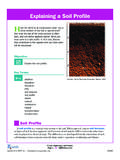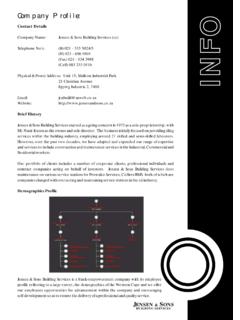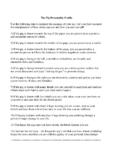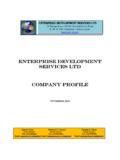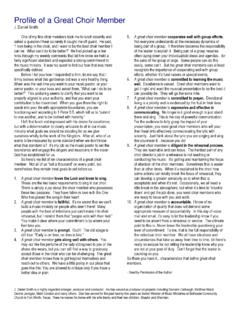Transcription of Brief Profile on Tobacco Control in Nepal - WHO
1 Brief Profile on Tobacco Control in NepalGovernment of NepalMinistry of Health and PopulationCopyright reserved with Ministry of Health and Population, Government of NepaliiiTobacco Controlin NepalBrief Profile onContentsForeword vAcknowledgements vii1. General information about Nepal 12. Tobacco use in Nepal 23. Types of Tobacco products used in Nepal 44. Tobacco Control in Nepal 65. Nepal and the global Tobacco surveillance system 86. MPOWER policy package in Nepal 117. Conclusion 238. Bibliography 24vTobacco Controlin NepalBrief Profile onForeword by Umakant Chaudhary Minister for Health and Population Nepal Tobacco use affects the health of men and women and particularly mothers and children. The most economically productive age groups are affected by the consumption of Tobacco products. It causes diseases, disability and death, and is the single largest preventable cause of death in the South-East Asia Region and the world.
2 As the countries have undergone epidemiological transition, chronic noncommunicable diseases caused by Tobacco are rapidly overtaking the more traditional causes of mortality. Member States of the WHO South-East Asia Region have been striving hard to Control the Tobacco epidemic, which is a global threat to public health. However, Tobacco Control in the Region remains a complex task as it involves socioeconomic and cultural dimensions. It is highly appreciated that WHO has been supporting the countries in their national efforts to reduce Tobacco Government of Nepal is fully committed to the alleviation of poverty in the country. In Nepal , prevalence of smoking and Tobacco use is in men and in women (NDHS, 2006), which is higher in comparison to other countries. Unfortunately, in Nepal Tobacco use is found to be higher among the poor and illiterate sections of the population.
3 It is, therefore, clear that measures to reduce the consumption of Tobacco products will also contribute to poverty reduction as well as save people from untimely deaths. Overall, it will improve the quality of , as a Party to the WHO Framework Convention on Tobacco Control (WHO FCTC), has undertaken a number of Tobacco Control initiatives over the last decades. The Ministry of Health and Population (MoH&P) has drafted the Tobacco Control and Regulatory Bill 2010, which includes most of the important provisions of the Framework Convention, prohibition of smoking in public places, on public transport and in workplaces; ban on all forms of Tobacco advertisement, promotion and sponsorship; pictorial health warnings in cigarette, bidi and other Tobacco packets; prohibition of sale of Tobacco to and by minors and pregnant women; establishment of a Tobacco Control and regulatory committee; establishment of a health tax fund, etc.
4 The final version of this Bill is in Parliament for , MPOWER policy package of WHO has been taken as a roadmap for Tobacco Control activities in Nepal . Policy formulation, advocacy, awareness with behaviour change and training activities have been conducted by the viTobacco Controlin NepalBrief Profile onNepal National Health Education, Information and Communication Center (NHEICC), which is the national focal point for Tobacco Control under the Ministry of Health and this context, this Brief Profile presents vital information related to the Tobacco Control programme in Nepal . it has reviewed the country situation, evaluated the weaknesses and demonstrated the way forward, which will guide us to plan and implement the Tobacco Control activities in our country. I hope this Profile will serve as an evidence base for the Tobacco Control programme in Nepal and will assist in making policy decisions in the area of programme development and resource allocation.
5 It will be equally useful and informative for development partners and stakeholders in providing the required support to the country for Tobacco , I would like to acknowledge the support and cooperation of WHO in preparing this Profile and expect that with the support of the organization the National Tobacco Control Progamme of the MoH&P will make further advancements in the near Umakant ChaudharyMinister for Health and PopulationGovernment of NepalviiTobacco Controlin NepalBrief Profile onAcknowledgements The National Health Education, Information and Communication Centre, Ministry of Health and Population, Government of Nepal acknowledges the support of the World Health Organization, Country office for Nepal and Regional Office for South-East Asia, New Delhi, and the Centers for Disease Control and Prevention (CDC), Atlanta, for providing technical and financial support in developing and printing the document Brief Profile on Tobacco Control in Controlin NepalBrief Profile on1.
6 General information about NepalNepal is situated in the South-East Asia Region and has a total land area of 147 181 square kilometres. Nepal is bounded by India on three sides and China's Xizang Autonomous Region (Tibet) to the north. West Bengal's narrow Siliguri Corridor or Chicken's Neck separates Nepal from Bangladesh. To the east lies Bhutan and India s Sikkim state. Nepal has a population of approximately 30 million with a growth rate of Nepal 's gross domestic product (GDP) for 2008 was estimated at over US$ 12 billion (adjusted to nominal GDP). Agriculture employs 76% of the workforce, the services sector 18% and manufacturing/craft-based industries about 6%. More than 80% of the people living in rural areas depend mostly on subsistence farming for their leaf production is falling every year due to declining interest in Tobacco farming.
7 About 2491 tonnes of Tobacco leaf were produced in 2009 2010 on 2534 hectares of land. Cigarette production was 9970 million sticks in 2006 2007, 10 710 million sticks in 2007 2008 and 11 130 million sticks in 2008 2009 (Ministry of Finance). 2 Tobacco Controlin NepalBrief Profile on2. Tobacco use in NepalThe World Health Organization s (WHO) STEP wise approach to noncommunicable disease risk factor surveillance (STEPS) was carried out in Nepal in 2007. The survey revealed that of men and 15% of women smoked Tobacco products and of men and of women used smokeless Tobacco . The prevalence of smoking among adult females in Nepal is one of the highest in the WHO South-East Asia 1: Prevalence of Tobacco use among men and women aged 15 64 years, Nepal , Tobacco usersTobacco productsSource: WHO STEPS Survey, 2007 The National Demographic Health Survey conducted in 2006 reveals that nearly one third of males ( ) in Nepal and while of females smoke cigarettes.
8 Nearly four in ten ( ) males use Tobacco products other than cigarettes. Use of Tobacco products other than cigarettes was reportedly low among females (5%).3 Tobacco Controlin NepalBrief Profile onFigure 2: Prevalence of smoking of cigarettes, pipes and other Tobacco products classified by men and women aged 15 49 in Nepal , NDHS, : National Demographic Health Survey 2006 Among male daily smokers 85% smoke cigarettes while 46% smoke cigarettes among female 3: Smokers of manufactured cigarettes among daily smokers (men aged 15 64 years), Nepal , 200714%86%Manufactured cigarettes Other smoking formsSource: WHO STEPS Survey, 2007 Source: WHO STEPS Survey, 2007 Figure 4: Smokers of manufactured cigarettes among daily smokers (women aged 15 64 years), Nepal , 200748%52%Manufactured cigarettes Other smoking formsSource: WHO STEPS Survey, 20074 Tobacco Controlin NepalBrief Profile on3.
9 Types of Tobacco products used in NepalDifferent varieties of Tobacco products are used in Nepal in both smoking and smokeless forms. The smoking forms are cigarette, bidi, hookah, sulfa and chillum or kankad. The smokeless Tobacco products include surti leaves, khaini, gutkha and paan with Tobacco ingredients. The major chewing form of Tobacco is paan with Tobacco and is most popular in the Terai region. Dry Tobacco -areca nut preparations such as gutkha and paan masala are popular in Nepal . Smoking is often seen as a symbol of independence and a modern fashion statement among the urban population, especially urban women and young people. Among rural women, Tobacco chewing is more socially acceptable than smoking, and among smokers bidi smoking is more popular than cigarette forms Cigarettes BidisSmokeless forms Khaini Gutkha Supari5 Tobacco Controlin NepalBrief Profile onTypes of apparatus used for smoking Tobacco Hookah Traditionally designed hookah Coconut shell used for filling Tobacco and water 6 Tobacco Controlin NepalBrief Profile on4.
10 Tobacco Control in NepalThe WHO Framework Convention on Tobacco Control (WHO FCTC) and NepalNepal signed the WHO Framework Convention on Tobacco Control (WHO FCTC) on 3 December ratified the WHO Framework Convention on 7 November Control BillA draft Tobacco Control and Regulatory Bill 2010 is under consideration in Parliament. The Bill incorporates most of the provisions of the WHO Control effortsThe Council of Ministers of the Government of Nepal passed an Executive Order in 1992 and 2010 on Tobacco -free initiatives such as the implementation of health warnings on Tobacco products; prohibition of smoking in public places, workplaces and on public transport; collecting health tax from Tobacco industries for the treatment of diseases caused by Tobacco use; allocation of funds to disseminate information and conduct education and communication activities on the harmful effects of Tobacco use.










